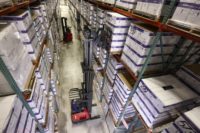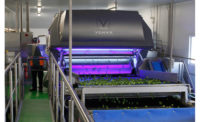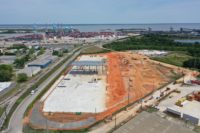Even warehouse managers and directors of operations for cold storage facilities are feeling the heat of heightened productivity goals. They’re being challenged to squeeze more SKUs in existing space, decide whether all of those employees are really needed and be prepared for potential disruption from business changes, such as merger and acquisition activity; not to mention expectations from consumers looking for variety in their grocery options.
So, how can leaders of refrigerated and frozen food warehouses beat the heat?
One way is to leverage new forklift features that help overcome common challenges of low-temperature environments, such as rising energy costs and harsh operating conditions.
Here are four tips that can help increase productivity:
Increase storage and transport density
Facility leaders are continuously being challenged to move as much product as possible and as quickly as possible. This often requires better utilization of existing space. In many instances, it can be less expensive to gain pallet positions by going higher with racking rather than expanding the warehouse footprint. Building up and not out to increase storage density within the existing space also eliminates unnecessary airspace that can cause cooling inefficiencies.
Of course, to go higher in the warehouse, you need a forklift that can optimize warehouse slotting by placing heavier loads at higher heights with faster speeds, while also maintaining safety standards with greater operator control and visibility. The key is finding a truck that can offer the higher heights and capacity as well as reduced cycle times through decreased time spent waiting for loads to lower.
The good news is that today’s forklifts can do this without expanding the outriggers to the point that the aisle would need to be widened to allow two trucks to pass. Depending on the turning radius of the truck, you may even be able to narrow the aisle width and add an additional aisle to the warehouse.
Heighten battery performance
Lead acid batteries are one of the most vital, and in some cases, one of the most frustrating aspects of managing a forklift fleet. When managed properly, batteries directly improve productivity via longer run times and lifecycles. For instance, some forklifts have regenerative lowering technology that recaptures energy as the mast is lowered and delivers it back to the battery. Certain forklifts are also designed with larger battery boxes that offer increased battery capacity.
New battery monitoring devices provide real-time data on battery activities, enabling managers to take a holistic and strategic approach to battery performance amid efforts to maximize productivity. Managers capitalizing on this technology can more accurately identify which charging method – fast or opportunity – works best for each battery and which batteries work best in certain trucks and applications. It’s this level of customization that truly creates productivity gains.
Leverage connected technologies
It’s one thing to view the forklift as a machine that moves product throughout the facility. It’s another to see the forklift as a mobile information technology hub. When considered through the latter lens, warehouse leaders can focus on real opportunities and avoid wasting time guessing at possible improvements or opportunities.
The simplest first step is utilizing a fleet and operator management system to gain visibility into an array of fleet and operator information, such as battery usage, impact history, truck utilization, OSHA compliance, service needs and more. Managers can see exactly how and when trucks are being used, so they can ensure all operators are achieving similar levels of productivity and safety and the fleet is sized properly for efficient performance.
Commit to operator comfort and safety
For many forklift operators, the forklift is their office. Outside of personal breaks and battery changes, they spend the majority of their day on a truck. That’s why the way they interact with that equipment has a big impact on overall warehouse productivity and safety. This is especially important in refrigerated and frozen food warehouses, where temperatures as low as -20°F can impact productivity and limit the amount of time operators can work in the environment.
It is vital to have forklifts that are designed to make it easier for operators to work comfortably and continually through their entire shift. For example, cold store cabins that are designed around the operator and feature ergonomic seating keep the cabin interior warm and the operator comfortable. Some cabins are also designed to ensure visibility from every angle, which is important in cold storage applications, where pedestrians and other operators may not see or hear as well. It is imperative that operators have personal confidence to maintain desired performance levels.
Conclusion
As managers look to increase productivity and efficiency within refrigerated and frozen food warehouses, the forklift should be at the top of the consideration list to uncover and realize opportunities to improve operations. Through increased storage and transport density, heightened battery performance, utilization of connected technologies and a renewed commitment to operator comfort and safety, perhaps the pressure to make productivity gains might feel less hot.



